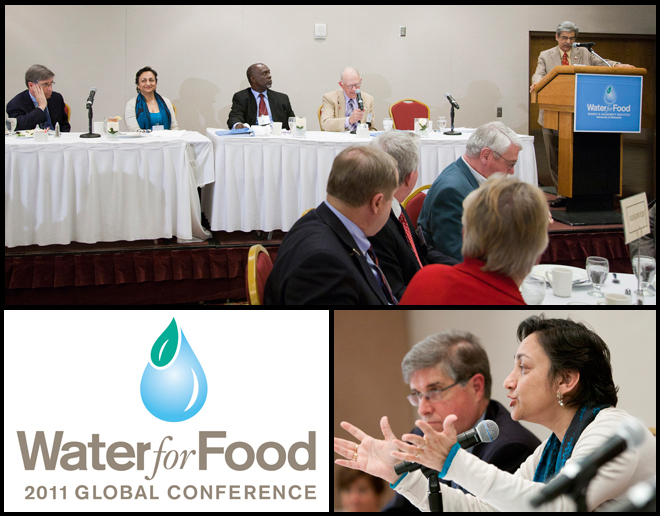
Of the Robert B. Daugherty Water for Food Institute’s three focus areas – research, education and policy – it may be the last one that proves most daunting in determining how to feed a growing world population with less water, several experts said May 4.
Reflections on policy challenges, in both the developed and developing world, were raised throughout the 2011 global Water for Food Conference sponsored by the institute, based at the University of Nebraska, and the Bill & Melinda Gates Foundation. Policy needs and concerns also came up during the closing panel discussion Wednesday afternoon.
Eugene Glock, a Rising City farmer with a long history of agricultural leadership in the state, was particularly pointed. He noted an ad-hoc survey of conference participants on May 2 in which 80 percent said they believed the research and technology are already available to manage water to meet growing world food demand.
“If we’ve got all the knowledge we need to address it, there’s a complete disconnect between that knowledge and the use of that knowledge,” Glock said. Glock, who once served on U.S. Sen. Bob Kerrey’s staff, said part of the problem is agricultural policy in the U.S. that doesn’t adequately incentivize water conservation.
He encouraged the Water for Food Institute to empower scientists as policy advocates. “Until the scientific community gets over its reluctance to deal directly with policymakers, we’re never going to accomplish what we need to accomplish.”
Mick Mwala, dean of the University of Zambia’s School of Natural Resources, echoed Glock, saying agriculture gets only “lip service” from policymakers in the developing world.
Simi Kamal, chairperson and CEO of the Hisaar Foundation in Pakistan, suggested getting policymakers more engaged in future Water for Food conferences. She also emphasized that agricultural policies must not overlook the human dimension. They must empower and engage “the dispossessed, the marginalized, the landless, (including) unpaid and underpaid women laborers on the farms in the developing world,” Kamal said.
If there’s a country that is the unwitting poster child for the global food crisis, it is Ethiopia, a country of 80 million where agriculture provides 85 percent of employment. About 95 percent of farmland is rain-fed, the climate is unpredictable and often brutal, farmers grow barely enough food to feed their own families and households survive on $2 to $3 a day. Ethiopia already has been the site of numerous widespread famines.
Expanding irrigation in Ethiopia and in other developing nations is key to growing more food and raising farmers out of devastating poverty. Charles Wortmann, a UNL agronomist, is among many from campus who has worked in Ethiopia. He said there’s been some success in adopting techniques from American agriculture, including skip-row planting and intercropping.
While partnerships with scientists in the developed world are part of the solution, one Ethiopian educator said his country’s educational system is failing its farmers.
Ethiopia’s universities began providing undergraduate education in irrigation development only in the mid-1980s and didn’t offer graduate education in that area until 2003, said Kindie Tesfaye of Haramaya University, which has a partnership with UNL that includes faculty and teacher exchanges.
“The higher learning institutions of Ethiopia have not yet played the role expected of them in irrigation and water management,” Tesfaye said. “There’s an urgent need for researchers to address existing extremely poor water management practices.”
Understanding what is needed in countries such as Ethiopia can be a challenge in “the land of center pivots watering quarter sections,” said Bob Yoder of International Development Enterprises. The need is to “get water in very small quantities to irrigate very small plots.”
IDE is two years into a pilot project training Ethiopian irrigation-well drillers. A farmer can get an irrigation well drilled for a $165 investment, which will result in an $840 increase in annual income in subsequent years. Later, he can upgrade for another $550 investment, which will give him $1,800 annual net return.
Nearly 300 well drillers have been trained so far. To get into business, a driller needs to invest about $1,247, but he will see annual income of about $4,200. And the venture creates jobs for laborers, with pay ranging from $727 to $970 a year.
Drilling for water in Ethiopia is not easy – drilling depth is limited by harsh land conditions, and the work is backbreaking. “But water is there,” Yoder said.
The third annual conference drew 450 participants from 24 nations. The fourth global Water for Food Conference is scheduled for June 24-27, 2012.
- Dan Moser, IANR News Service